Farewell Zen, Hello Ryzen: AMD’s Eight-Core CPU Runs At 3.4GHz+
When AMD launched its Bulldozer architecture in 2011, it quickly became clear that the FX-8150 wasn’t a CPU capable of battling Intel in the enthusiast space, and we knew we had at least three subsequent revisions to sit through before a successor would take its place. This frustration wasn’t ours alone. At the Technology Summit last week in Sonoma, California, AMD CEO Dr. Lisa Su contrasted her excitement about Zen with a stinging critique of progress in the enthusiast CPU space, stating “…we believe that there has been no innovation in desktops over at least the last five years.”
But the moment of truth is close at hand. AMD maintains that its next-gen design will be made available in Q1 2017, and based on what we just saw, the processor's specifications are certainly solidifying ahead of an imminent debut.
For starters, it’s no longer referred to by the architectural code-name "Zen," or by the desktop-specific implementation "Summit Ridge." Instead, you’ll see those first CPUs show up on store shelves under the "Ryzen" brand. (As in, the company's CPU portfolio is reborn, or risen. Think of that what you will.) For now, it’s distinct from the FX moniker, which just doesn’t have the enthusiast cachet it did 13 years ago.
By AMD’s own admission, Ryzen was designed for the high-end desktop market. The company already let us know that its top-end model would be an eight-core design with simultaneous multi-threading support, allowing 16 threads to better utilize the processor’s resources.
Early leaks showed engineering samples running at 2.8GHz. Then, AMD demonstrated a 3GHz Summit Ridge part against a Core i7-6900K artificially limited to 3GHz in Blender. Now we can report that the flagship Ryzen model will sport at least a 3.4GHz base clock (yes, it could end up higher). AMD isn’t saying how much headroom is available for boost, but frequency is expected to ramp up even more in lightly-threaded workloads.
To give us an idea of how the architecture fares at a static 3.4GHz, AMD ran another head-to-head benchmark against the Core i7-6900K at its Technology Summit event. This time, Intel’s CPU was operating in an out-of-the-box configuration (3.2GHz base, Turbo Boost up to 3.7GHz), and in a HandBrake-based video transcoding task, Ryzen scored a narrow win. Now, we weren’t able to inspect both test machines, and AMD naturally picked a workload it knew it’d excel in. But the fact we’re up 400MHz since August, and able to take on a stock -6900K, is promising.
As an aside, I would have loved to see AMD compare Zen to Skylake and/or Steamroller in a lightly-threaded benchmark, not only to encourage discussion of IPC improvements, but also to show the company was able to overcome one of Bulldozer’s weaknesses.
Get Tom's Hardware's best news and in-depth reviews, straight to your inbox.
Some Config Details And SenseMI
At Hot Chips 28 back in August, AMD’s architecture briefing revealed that each core has its own 512KB private L2 cache. So, a CPU complex (CCX) composed of four cores would have 2MB of total L2 and 8MB of L3 divided into four slices. An eight-core configuration consists of two CCXes, yielding 4MB of L2 and 16MB of L3 across the processor. This is what we're expecting from the flagship Ryzen chip.
The last piece of new information AMD is sharing about Ryzen involves a collection of features under an umbrella called SenseMI Technology. Three of its capabilities are targeted at optimizing efficiency, or maximizing performance within the processor’s thermal and power limits. Two others highlight intelligence built into the architecture, which should make it inherently faster.
The first, Pure Power, describes a modern closed-loop control system able to monitor temperature, clock rate, and voltage. AMD CTO Mark Papermaster said there are hundreds of sensors embedded into different parts of the die. These sensors pipe telemetry data to a management unit, which is then able to control individual pieces of IP. Constant adjustments based on Pure Power’s various inputs purportedly let AMD reduce consumption for any given level of performance.
Inversely, Precision Boost aims to maximize clock rate at a given power level using the same control loop. It employs another algorithm that makes on-the-fly frequency adjustments in ~25MHz increments based on Pure Power’s alterations. In other words, this exploits the power headroom leftover after optimizing the CPU's behavior to facilitate higher performance.
As you might imagine, there are ways enthusiasts can affect the readings taken by Pure Power, thereby influencing Precision Boost. Cooling plays a very obvious role in the processor’s operating temperature, so AMD said it will allow clock rates beyond Precision Boost’s normal limits in cases when more aggressive coolers are used. The company calls this Extended Frequency Range and said it’s activated automatically. Details on the technology are scarce, but we wonder if there’s a defined limit to XFR’s range. Also, it would seem as though the demanding workloads able to benefit from higher frequencies would be the ones most likely to impose elevated temperatures.
Regardless of environmental variables, the fourth SenseMI “feature” should augment performance at all times, though it’s unclear whether any of what AMD calls Neural Net Prediction is new information or just a marketing term for known improvements to Zen’s front-end. The same goes for Smart Prefetch. Papermaster conceded that he’d previously discussed Zen’s back-end hardware, but hadn’t yet spoken to the algorithms responsible for ensuring data is resident in cache when it’s needed. Thus, Smart Prefetch represents AMD’s effort to add sophistication to the way its architecture hides latencies and minimizes pipeline stalls.
From there, AMD reiterated interoperability between Ryzen and its AM4 platform, although none of what the company is saying today about its supporting subsystems is particularly fresh. Ahead of Hot Chips, we were told AM4’s highlights would include DDR4 memory, PCIe 3.0, USB 3.1 Gen2, NVMe, and SATA Express. The company still isn’t being specific about how many channels, lanes, or ports the first motherboards will expose, though.
-
Snipergod87 Finally more SATA Express support, just want I need for those 0 SATA Express drives available.Reply -
itsmedatguy Is there any word on it having access to DRM 4K content? I just got a really nice 4K monitor and it seems like only the Intel 7XXX series is going to have access to streaming 4K content...Reply -
blppt Agreed with the reviewer that they should have tested more real world, more lightly-threaded stuff---Bulldozer/Steamroller would have also excelled at this particular great threaded benchmark, and we now know that meant very little in the real world.Reply
Then again, its not like Intel doesnt cherry pick benchmarks too. -
nycalex finally! hooray AMD! give intel some competition for the love of god.Reply
i'll still buy intel, and hopefully at a cheaper price.
i know, i'm being an hypocrite, but lets face it, no way in hell that zen will dethrone even a skylake i7. -
bgunner After reading both articles, the one from here and the one from Anandtech, I'm wondering if this "extended frequency range" is a way AMD is will try to limit overclocking and exactly how it will effect overclocking.Reply
Don't take my hobby away now.... -
QT96 Reply19000513 said:finally! hooray AMD! give intel some competition for the love of god.
i'll still buy intel, and hopefully at a cheaper price.
i know, i'm being an hypocrite, but lets face it, no way in hell that zen will dethrone even a skylake i7.
I don't think it was meant to dethrone. It was meant to give some fight back and at least shake up the market. Of course, AMD can't do the same price as Intel, so I hope that maybe 800$ 8 cores compare to Intel 1k$ for 8 cores should be good enough to steal some market share.








